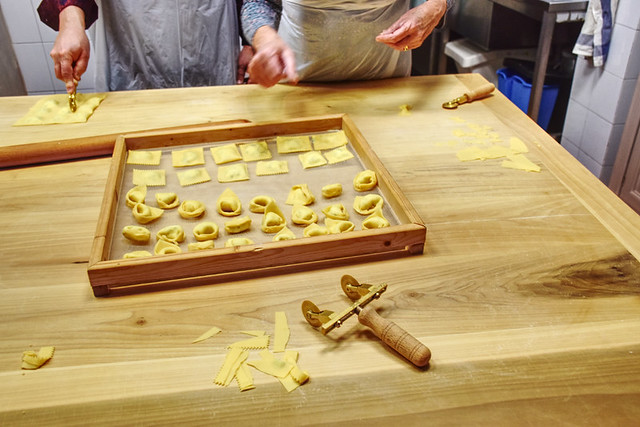‘You don’t want parmigiano with that.’
There was no question mark at the end of the sentence. It was a statement, firmly delivered.
‘No?’ Andy tentatively asked, still hoping there might be a chance she might get a sprinkling of Parmesan cheese on her mushroom risotto.
‘No! And I will bring black pepper to your table, but it wouldn’t be right to use it.’
The waiter at Trattoria da Danilo in Modena in Italy’s food valley, Emilia Romagna, was of the assertive variety. We’d already battled him over his insistence we should order tortellini, only narrowly fending him off with excuses of having eaten tortellini for three days running, including cooking it ourselves. But he wasn’t going to budge on the Parmesan.
A friend often makes references to it not being the done thing to drink a cappuccino in Italy after 11:00 (*1). I’ve never really subscribed to rules set in concrete when it comes to culinary matters because, by its very nature, the art of cooking is a constantly evolving beast. It has been ever since the likes of Sir Francis Drake (in reality it was probably the Spanish) introduced the humble spud to Britain and Portugal’s great explorers brought chillies from South America to India. Additionally, even long-established traditional dishes can vary from household to household in most countries.
In most countries, not Italy.
Despite having visited the country on numerous occasions, this was the first time we’d been aware of just how many set-in-concrete rules there were when it came to cooking and dining etiquette. But then, this time we were on a gastronomic odyssey through Emilia Romagna. The objective was to learn about the region’s food, not just to eat it.
The rules of Italian cooking – forget what you think you already know
We fell foul of the rules of Italian cooking in a kitchen tucked away the end of a shadowy courtyard off a nondescript street on the western edge of Bologna’s old centre. We were there to learn how to cook pasta. Virtually the first thing our learned tutor told us about making pasta was that it must be done by hand; pasta machines should be consigned to the bin. This piece of information instantly put paid to any thoughts of trying to impress said teacher by telling her we’d already made fresh pasta at home using the pasta machine we bought less than a year ago. Instead, and wisely I felt, we kept shtum.
As the evening progressed, as well as learning how to make tortellini, ravioli, and tagliatelle, we were taught:
- You should serve Bolognese sauce (ragù alla Bolognese) with tagliatelle, never with spaghetti. We already knew this one thanks to our authentic Italian cookbook.
- That onion and garlic (*2) hate each other and should never be paired in cooking. We recently found this out watching Gordon Ramsay’s Next Level Chef when Italian chef Gino D’Acampo went ballistic after he found one chef frying garlic and onion while making an Italian dish.
- The ‘authentic’ Bolognese sauce in our Italian cookbook at home bore barely a passing resemblance to the real thing. The amount of vegetables used in ragù alla Bolognese can be described as minimalist at best. For four people, the vegetable contribution amounted to half an onion, a small carrot, and a wee bit of celery.
There is no room for manoeuvre, certain dishes are cooked a certain way. That is how it is.
Tagliatelle goes some way to explaining why rules can be so exact, so rigid.
The story about its origins is dodgy. Local chef Zefirano was so captivated by Lucrezia Borgia’s long, golden tresses when he saw them during her visit to Bologna in 1487, he replicated them in fresh pasta form.
While the origins story may be fanciful, the recipe for authentic tagliatelle is not. In fact, a good knowledge of mathematics would come in handy. The official recipe dictates the width of tagliatelle should be 12,270th of the height of the city’s Asinelli Tower when cooked (it works out as 8mm). To achieve this, the uncooked strips must be between 6.5 and 7mm otherwise the pasta is not considered the real deal.
The original recipe which decrees this is kept under lock and key at Bologna’s Chamber of Commerce inside the Palazzo della Mecanzia. And it is not alone. Numerous recipes are registered there, each detailing the one specific way in which the dish or product it refers to can be made if it wants to be considered authentic.
Those are the rules. Gently dictatorial maybe, but the result is arguably the best cuisine in Europe.
Our view is when in Rome, do as the Romans do. However, when not in Rome (or Bologna in this instance) do whatever is easier, especially if the end result is virtually the same. When we returned home from Italy full of Italian culinary knowledge, we set up our pasta machine and made ravioli and tortellini. Was it authentic? Probably not. Was it delicious? We think so.
(*1) – There’s a good reason Italians don’t drink cappuccino after 11:00. They believe consuming milk after a meal plays havoc with the digestive system, so milk is avoided after food is taken. Breakfast doesn’t count as it’s generally only a coffee and a pastry, so cappuccino is okay until lunchtime-ish.
(*2) – If garlic in cooking causes looks of disdain, then how do the Italians explain garlic bread? Because it’s not Italian, is what a food specialist told us. Italian-Americans are responsible for it, and it shouldn’t grace the menu of any authentic Italian restaurant. Their loss on that one if you ask me.









Be the first to comment